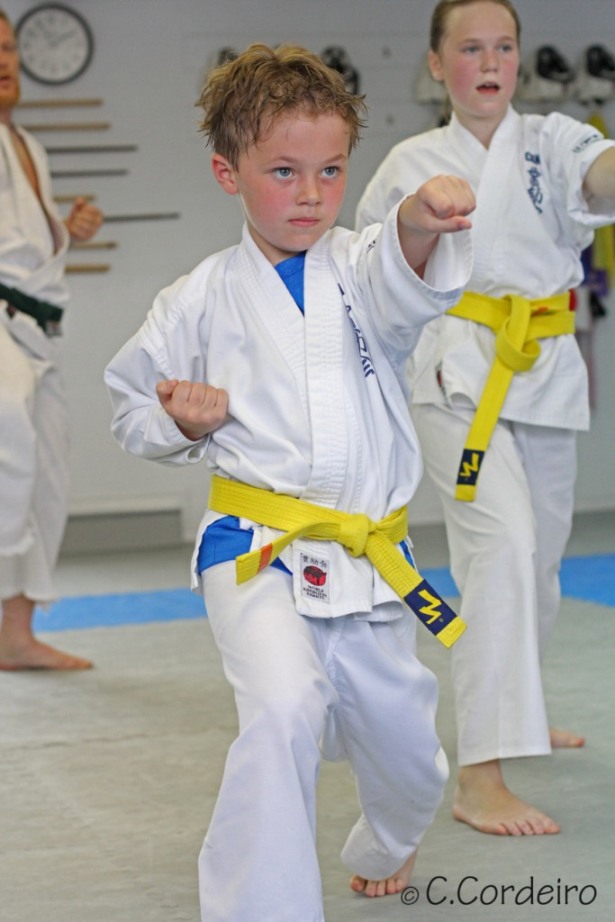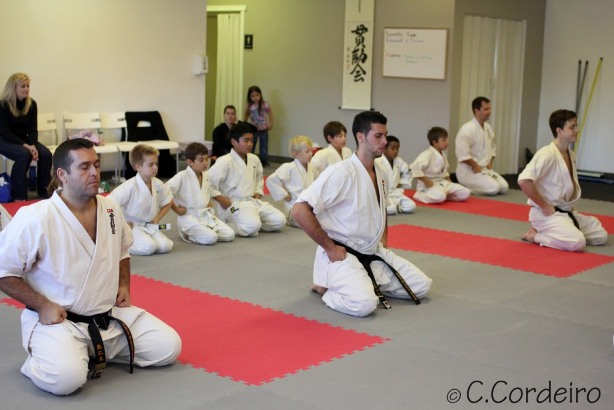Practical Info
At World Kanreikai Karate we practice and teach a Japanese style of karate in a traditional fashion. Japanese expressions used in class contribute first, to perpetuate our art’s Japanese tradition and second, to unite members of all World Kanreikai schools whose native tongue can be English, French, Polish or any other language.
In every Kanreikai school, we observe rules of conduct that inspire our students to be courteous, respectful and grateful at all times, at the dojo as well as anywhere else.
OSU! AN IMPORTANT THREE-LETTER WORD
Among all the Japanese expressions used at our schools, “OSU” is probably the one most frequently heard. This short three-letter word encompasses the fundamental principles of martial arts and expresses a quest for physical and spiritual harmony at the dojo and in daily life.
More specifically, “OSU” means patience, respect and appreciation.
Patience
The physical and mental strength of each individual steadily develops by means of a rigorous training that constantly requires to overcome difficulties. One must be aware that practicing karate is not “racing toward a black belt”. A student must first establish his/her goals and then work steadily to achieve them one at a time, patiently, by constantly refining his/her skills.
Respect
A student’s decision to engage in intensive training is in itself a demonstration of self-respect. Respect for the teacher and other students follows naturally. This mutual deference at the dojo then spreads to everyday life.
Appreciation
Before, during and after each training session at the dojo, students often express their appreciation of their teacher and fellow students by saying “OSU”. It is a way to acknowledge and thank them. In return, saying “OSU” recalls that one belongs to the group. It is a way for each student to take his/her place and show solidarity, willingness and determination.


Rules of conduct in Kanreikai schools
Respect and discipline
In World Kanreikai schools, every student and member abides by a code of conduct that ensures a respectfull and orderly environment for all. Indeed, respect of a student for his/her masters, instructors and fellow karatekas is a most fundamental value at the heart of traditional martial arts.
Newcomers naturally imitate more advanced students and comply rapidly with the rules. Actually, the fact that all Kanreikai members are wearing the same uniform (dogi) to train at their dojo does generate a sense of belonging and mutual trust that makes our rules of conduct a welcome and natural part of the life at the dojo.
Code of Conduct
- Bow and say “OSU!” when entering or leaving the dojo
- Express patience, respect and appreciation by saying “OSU!”
- Address the head instructor of the dojo as “Sensei”
- Address a Black Belt karateka as “Senpai”
- Swiftly line up in a straight line when called by the instructor at the beginning of a class
- Answer “OSU!” clear and loud when called by your name
- Shake Sensei’s or a Senpai’s hand with two hands
- If showing up late, remain at the entrance of the dojo in a kneeling position (seiza) and wait for Sensei to invite you to take place on the tatami
- When asked to withdraw from the tatami, kneel down (seiza) along the wall of the dojo and wait for Sensei to invite you to sit down (anza); quietly watch the training session
- Ask Sensei permission to leave the dojo during a class
- Never use coarse or offensive language
- Make sure to always wear a clean uniform (dogi)
- Keep fingernails and toenails short
- Do not wear shoes
- Do not wear jewels
- Do not eat, drink or chew gum
- Do not fight without permission from Sensei
- Do not use fighting techniques outside the dojo – unless you absolutely need to defend yourself
- Do not use equipment without permission from Sensei
- Respect and use the equipment correctly during training

Basic Glossary – from Japanese to English
These are some Japanese words and numbers that are frequently used at World Kanreikai Karate schools. Being common to all Kanreikai members of our organization, this Japanese vocabulary allows us to visit and train together!
You will also find below the wording of the Japanese salutes that are recitated at the start and end of each training session.
Frequently used Japanese words and numbers and Japanese salutes
Japanese Words
| JAPANESE | ENGLISH |
|---|---|
| Anza | Sitting position, relaxed, cross-legged with straight back |
| Dan | Black belt qualification level |
| Dojo | Room where martial arts are being practiced; martial arts school |
| Hajime | Start |
| Hanshi | Grand Master |
| Hidari | Left |
| Ibuki | Breathing out technique (a long exhalation followed by a short expiration) |
| Kamaete | Starting position |
| Karate | Japanese martial art practiced with bare hands and feet |
| Karateka | A karate practitioner |
| Kata | Imaginary Fight |
| Kiai | Shout to concentrate power (power explosion) |
| Kiai Irete | Movement with a shout (Kiai) |
| Kihon Waza | Basic Techniques |
| Kohai | Junior student relative to one’s qualification level (Kyu) |
| Kumite | Fight |
| Kyu | Qualification level (from White belt to Black tip) |
| Mawate | Turn |
| Migi | Right |
| Mokuso | Meditation |
| Naore | Return to starting position |
| Nidan | Second dan |
| Obi | Belt |
| Otagai | Student |
| Rei | Salute |
| Sandan | Thitd dan |
| Seiza | Kneeling position, fists tight on hips, straight back (for salute and meditation) |
| Senpai | Senior student relative to one’s qualification level (Kyu); Black belt karateka |
| Sensei | Teacher in charge of the school |
| Shihan | Master |
| Shodan | First dan |
| Tatami | Training mat |
| Yamei | Stop |
| Yoi | Ready |
Japanese Numbers
| JAPANESE | NUMBER | JAPANESE | NUMBER |
|---|---|---|---|
| ichi | 1 | ||
| Ni | 2 | Niju | 20 |
| San | 3 | Sanju | 30 |
| Chi (Yon) | 4 | Yonju | 40 |
| Go | 5 | Goju | 50 |
| Roku | 6 | ||
| Sishi (Nana) | 7 | ||
| Hachi | 8 | ||
| Ku | 9 | ||
| Ju | 10 | Kyaku | 100 |
Salute at the beginning of each training session led by a Shihan, Sensei or Senpai
Hanshi Ni Rei – Mokusu – Mokusu Yamei, Shihan (Sensei, Senpai) Ni Rei
Salute to Hanshi – Meditation – End of meditation, salute to Shihan (Sensei, Senpai)
(Training starts)
Salute at the end of each training session led by a Shihan, Sensei or Senpai
Hanshi Ni Rei – Mokusu – Mokusu Yamei, Shihan (Sensei, Senpai) Ni Rei
Salute to Hanshi – Meditation – End of meditation, salute to Shihan (Sensei, Senpai)
(Training has ended)
Sensei, Senpai Otagai ni Rei
Mutual salute between students, Senpai, Sensei
